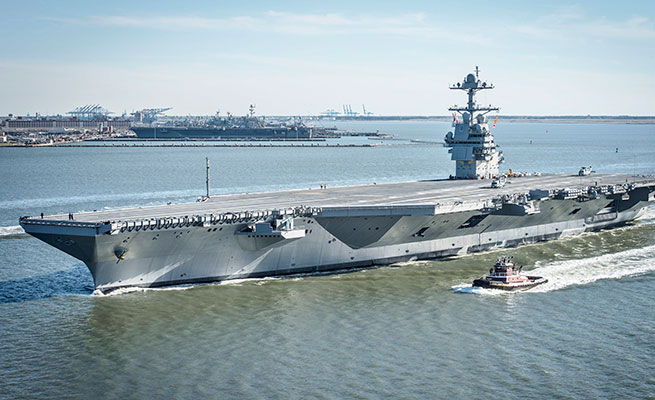USS Gerald R. Ford

USS Gerald R. Ford is the lead ship of her class of United States Navy aircraft carriers. The ship is named after the 38th President of the United States, Gerald Ford, whose World War II naval service included combat duty aboard the light aircraft carrier Monterey in the Pacific Theatre.
Construction began on 11 August 2005, when Northrop Grumman held a ceremonial steel cut for a 15-ton plate that forms part of a side shell unit of the carrier. Scheduled for delivery in 2015, Gerald R. Ford was delivered to the Navy on 31 May 2017 and formally commissioned by President Donald Trump on 22 July 2017.
The combat system for the Navy’s newest and costliest warship, the $13 billion Gerald R. Ford, “has yet to demonstrate that it can effectively” defend the aircraft carrier from anti-ship missiles and other threats.
The Navy’s three tests so far of the Ford’s self-defence system on board a specialized vessel designed to evaluate performance were “not adequate to assess the combat system’s capability against supersonic antiship cruise missiles and subsonic manoeuvring missiles, and there were no future test events planned against threats that could provide additional data,” according to the testing office.
Problems
The vessel’s Gatling gun-like system “experienced numerous reliability failures that in several cases prevented the system from executing its mission,” the test office said.
After a series of additional evaluations and exercises with the Ford’s air wing, the plan is for the carrier to “to visit multiple theatres of operation with multiple allies”.
The Navy is confident in the vessel’s combat systems. “She’s been engaged against her required threats and we’ve done those tests at sea, they’ve been evaluated and she’s achieved her certification in the combat systems area,” Downey said.
USS Gerald R. Ford (CVN 78) is the lead ship in the Ford-class of aircraft carrier, the first new class in more than 40 years, and will begin the phased replacement of Nimitz-class carriers.
Mission
The Sailors who serve aboard Ford are tasked with ensuring the ship is able to execute national tasking for decades to come.
Although it appears similar to a Nimitz-class aircraft carrier, there are many features that make Ford unique. First-in-class technology includes a new nuclear plant, the ability to generate nearly three times the amount of electrical power, innovative advanced arresting gear and the electromagnetic aircraft launch system (EMALS).
EMALS replaces the steam catapult system traditionally used to launch aircraft and will expand the aircraft launch envelope, paving the way for innovations in manned/unmanned aircraft as well as providing the opportunity for other technological advancements in the future.
Naming
In 2006, while Gerald Ford was still alive, Senator John Warner of Virginia proposed to amend a 2007 defence-spending bill to declare that CVN-78 “shall be named the USS Gerald Ford.”
Performance improvements
Gerald R. Ford is intended to be the first of a class of aircraft carriers that offer significant performance improvements over the previous Nimitz class. Gerald R. Ford is equipped with an AN/SPY-3 and AN/SPY-4 active electronically scanned array multi-function radar, and an island that is shorter in length and 20 feet (6.1 m) taller than that of the Nimitz class; it is set 140 feet (43 m) farther aft and 3 feet (0.91 m) closer to the edge of the ship. Replacing traditional steam catapults, the Electromagnetic Aircraft Launch System (EMALS) will launch all carrier aircraft.
Final software fixes for some of the problems were delayed until after the ship’s post-shakedown availability in 2019.
Operational and major system testing
In January 2014, the annual Director, Operational Test and Evaluation (DOT&E) report recorded that critical ship systems in lab and test environments (including the EMALS, Advanced Arresting Gear (AAG), Dual Band Radar, and weapons elevators) were not reliable enough and needed more testing and improvements.
In 2018, the Navy requested to delay shock trials for at least six years in order to speed up the ship’s deployment, but this request was denied.
Delivery
On 31 May 2017, Newport News Shipbuilding delivered Gerald R. Ford to the U.S. Navy and her status was changed to Special, in service.
According to a GAO report in mid-2020 the Gerald R. Ford was still reporting significant problems with the operation of its weapons elevators, while a DoD report in early 2021 stated that the ship was still not combat-ready, citing continuing problems with the Electromagnetic Aircraft Launch System (EMALS).




